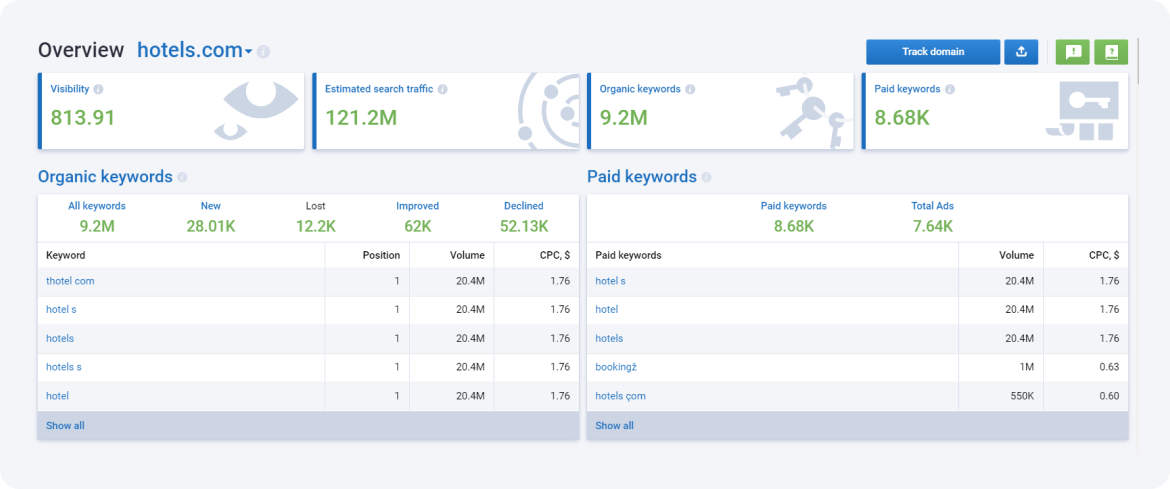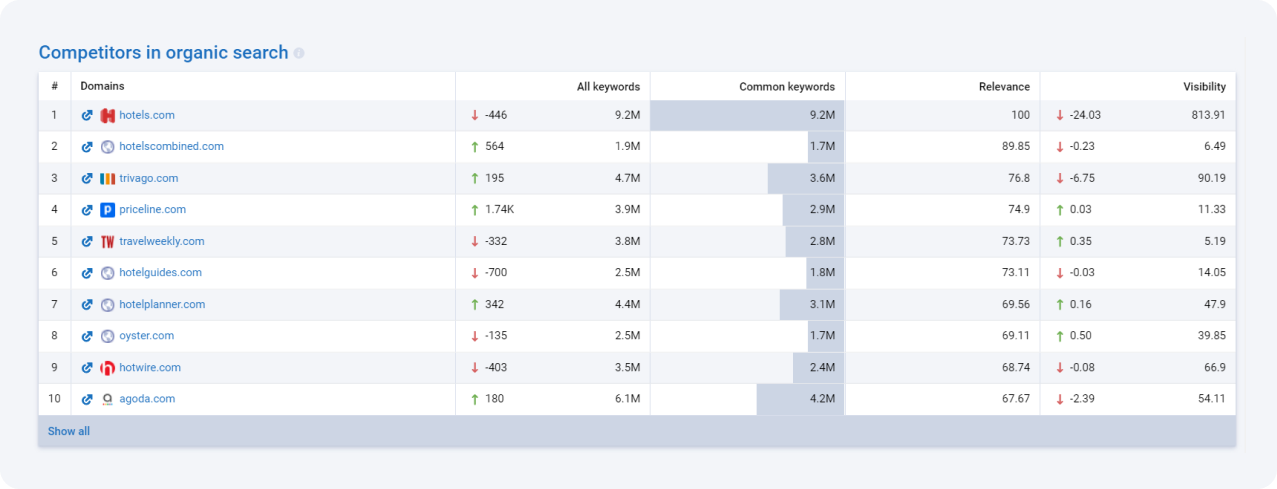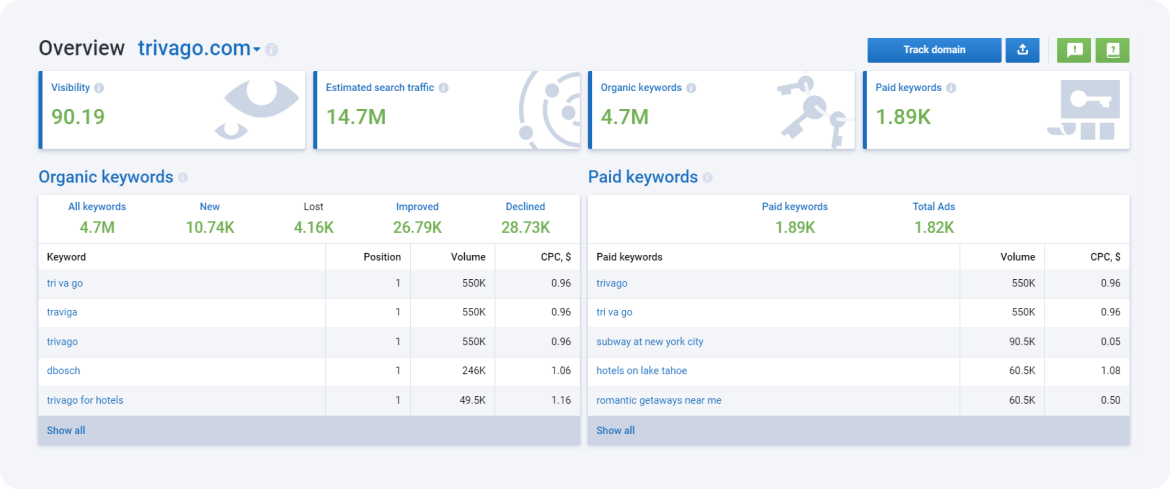Start Exploring Keyword Ideas
Use Serpstat to find the best keywords for your website
E-Commerce And Competition: How To Compete With Market Leaders In Organic Search

When it comes to SEO, things are not much different. You must predict your competitor's every move if you're to have any hope of besting them.
SEO professionals often look at market leaders in the fight for organic search rankings rather than focusing on their closest rivals. While we can learn a lot from market leaders, this is not always the best way to approach your SEO strategy.
Unless you know who you're fighting for your place under the sun, you won't know what strategy to employ and how to come out on top. So, before we get into specific organic search tactics that will help you beat even the biggest companies in your industry, let's discuss the mechanics of discovering your immediate competition.
How to Find Your True Organic Search Competitors?
Getting to know your competitors helps you:
- Learn what you're up against
- Know your actual chances of obtaining a top ranking for a given keyword
- Understand the strategies and tactics that work for the industry leaders so that you can implement them at an even higher level.
You may already have a few companies in mind, especially if you've been in the business for a while. There are likely a few organizations that you've come to consider your rivals since they tend to occupy the same section of the market.
However, the companies that you think of as your direct competitors in terms of business may not be the same ones you should be focusing on when it comes to your SEO battle. Search engine optimization and business success are related. Still, they do not always go hand in hand, so an industry leader in sales may not have the highest-ranking result on Google for a relevant keyword.
Let's take a look at the steps you need to take to identify and outrank your SEO competition.
Discover your True SEO Competitors
First, you need to look at every business you're sharing market space with. Then, it's time to look at how well they are doing on the SEO front. At this point, you can create a list of SEO market leaders.
A quick and easy way to do this is to analyze your website through Serpstat. This gives you a broad palette of data, including a list of sites similar to your own. These results should give you a pretty clear idea of your digital competition.
This is where you can begin to shift your strategy to focus primarily on these competitors.


Understand Your Competition's Performance Level
In our example, one of the biggest rivals of Hotels.com is Trivago, so we can take a closer look at the latter's overview page. Here we see that Hotels outperforms Trivago in all segments, with much higher visibility and estimated search traffic. That said, Trivago does have a relatively competitive organic keywords rating of 4.7 million.

Eliminate Low-Trending Competitors
To do this, you'll need to look into their organic search trends individually. Your goal is to determine whether each of these companies is a genuine competitor/market leader over the long haul, or if they're simply having a strong week.
So how do you rule out these low-trending "pretenders" and focus on the true champions?
We regret to inform you that there aren't any shortcuts to this. You'll need to do the legwork, researching, plotting, and comparing each of your potential competitor's SEO trends over an extended period.
If a company has a consistent high trend or has managed to hold its increase in search traffic gains for at least a quarter, they're worth a second look. On the other hand, if a potential competitor simply has an uncharacteristic uptick in a sea of sub-par results, you should focus your efforts elsewhere.
In the screenshot below, we can see that Trivago has had a decline in both its visibility and traffic over the past year. This means that Hotels.com should be looking elsewhere for inspiration on advancing its strategy. However, if Trivago had a sudden spike in traffic and visibility, Hotels would want to find out what changes their competitor recently made.

Identify Your Competitors' Top-Ranking Pages
Looking at your closest competitors' trends helps you to an extent, but you'll also need to know which pages they use to drive the most organic search traffic to their websites. This enables you to perfect your own digital marketing and SEO strategy.
To identify your rivals' powerhouse content, you'll need to find their top-performing pages. Thankfully, with Serpstat, this is easy to do. All you need to do is scroll down to the Top pages section of the Domain Analysis.

If you take a closer look at the screenshot above, you'll see that Trivago's third-best landing page is focused on cheap family vacations. This shows that many people are interested in traveling on a budget with their families.
With that information, Hotels.com and other travel-oriented websites have a strong starting position to create well-researched, engaging content that caters to that particular audience.
How to Outperform the Biggest Brands in Your Industry?
Despite your unwavering optimism and a metric ton of research on your closest rivals, you seem to be hitting wall after wall. There are no technical issues on your website, even your content is top of the line, and you're crushing it with the guest posts and backlinks, but your website is still not at the top of the SERPs.
Things are looking increasingly hopeless. Perhaps your market is simply too competitive. The brands you're up against are spending millions of dollars on marketing and have the firepower to beat you into the ground with brute force. You cannot beat them at their own game.
Think David and Goliath. You can't just take the big guys on in simple hand-to-hand combat. You need a slingshot, and you need to pick your battles carefully.
Chances are you're growing tired of this metaphor, so let's talk about what you can do to take the fight to the giants.
Exploit Their Weaknesses
● Slow decision-making process — Many people need to be on the same page before anything noteworthy can be done in a big multinational corporation. This means significant decisions can take weeks, months, or even years. This is the advantage of small businesses. Like David vs. Goliath, this is your chance to play to your agility.
● Internal politics — Big companies are not great at executing content marketing and SEO strategies because of the sheer number of people involved. Each person has their own idea about how things should be done, and different schools of thought quickly emerge. This often slows progress down to a halt.
● Outdated software — You'd be surprised at how many huge websites run on legacy platforms. This means they often run into problems not only related to SEO but the general operation of their website.
Hopefully, the three weaknesses listed above have got you believing that market leaders are not unbeatable in the SEO game. However, as much as we like an underdog story, you'll need a lot more than belief to come out on top. Thankfully, you have a few advantages of your own, and it's time to focus on those.
Play to Your Strengths
As one of the smaller fish in the pond, you may not have a huge budget or a massive team of Ivy League-educated digital marketing professionals. However, that doesn't mean you have no weapons in your arsenal. Let's take a look at a few "slingshots" you can use to take down the Goliaths in your niche:
● Guts — You're not getting anywhere without some courage. We don't mean this in the simple sense of having the bravery to put up a fight — we mean taking risks that your big-league opponents may not dare to take. Use the fact that you don't need a dozen legal experts to sign off on every campaign idea and piece of content you're looking to publish.
● Grit — Your willingness to go the distance to beat the market leaders is likely much more potent than their willingness to beat you. They're either in a relatively comfortable position, or they're fighting whomever they consider their biggest competitors. Either way, they've got their gaze focused elsewhere, and this is your chance to strike. You have everything to gain and very little to lose, while the opposite is true for them.
● Gait — You're flexible, quick, and agile. As we mentioned above, you don't have to have each of your ideas signed off by several layers of upper and middle management. A great idea could come to you in a dream and become part of your marketing strategy at 9:00 a.m. the following morning.
In summary, a smaller brand, such as your own, can come up with ideas, execute campaigns, and correct course much faster than any market leader. There's nothing holding you back, and you have everything to gain.
Find Less-Contested Topics
Forums like Reddit and Quora are your friends here, but so is Google Trends. These are all ways to keep your finger on the market's pulse and publish content around any emerging trends. If this content performs well, make sure to keep covering it. You'll develop a tight-knit community of readers in no time.
Make Sure You Have the Best Content
Once you find a low-competition keyword/topic to rank for, create a high barrier to entry by making your content the absolute best out there. How do you do that? You publish complete guides on the topic that not only have all the bases covered but look awesome as well.
Going the extra mile to make sure your content is top-shelf will pay dividends by preventing less driven competitors from even attempting to outperform it.
Look for More Accessible Markets
For smaller brands, the first step of the website development process should always be to create a business case exploring the market they're looking to breach. The great thing about being a smaller brand is that you can go through this process much faster than any colossal brand, for the reasons detailed above. This also means you can retreat from a market quickly if you feel a Goliath looming.
The trick is to test the waters in a market where none of the potential competitors have a strong presence. Invest more where you see potential and take things one step at a time. Remember, you can always pivot.
Here are the two most notable advantages of entering a low-contest market:
- There's a potential for exponential growth if you start off on the right foot.
- You can take the other competitors by surprise as they battle each other out for the top step on the ladder.
All this talk of low-competition markets may have you at the edge of your seat, but you won't get far unless you know where to look. Again, we're afraid there are no shortcuts here. You'll need to do old-fashioned research and use whatever data you already have to find the markets with the highest potential.
Use Desk Research to Find a Promising Market
To start with, map out all the markets your business could potentially cater to, and perform meticulous research of the competition within those markets using the Serpstat tool as explained above.
If the biggest brands on the scene seem to be showing low levels of competitiveness, you might be in with a shot. However, a lack of elite players doesn't quite mean you're in the clear just yet. There could still be lots of successful brands that you can't outperform without a significant degree of effort.
Presuming that this is the case, your best bet may be to leave this market altogether and look for a more straightforward path to the top.
In case you already have some data about which demographics like your products or services, make sure to use it to your advantage. Inspect your analytics platform for markets that convert well and see if you can improve your market share there.
Localize High-Performing Content to Serve a High-Potential Market
You often don't need to spend too much time looking for topics to rank for in a new market. All you need to do is create a localized version of the same content that worked well in another market, and you'll likely get great results.
The less competition, the better, because it is easier to have the best content available, which in turn means you'll rank more quickly
Control Your Online Reputation
What you need to do is take proactive steps to get your content into as many channels as possible, building your online reputation as you go.
Actively Manage Reviews and Testimonials
To make sure you have a rock-solid online reputation, you should list your company on sites like Yellow Pages, Bing Places, Yelp, and Google My Business. That said, don't think that by simply putting your business on these websites, you've completed your work. In fact, this is where the real work only begins.
You'll need to keep track of customer reviews on each of these websites, as well as any comments on social media platforms like Facebook, Twitter, and Instagram. Not only do you need to try and respond to every negative review and comment, but you need to do so in a non-confrontational way, validating your customers' concerns and offering to rectify the problem in the best way you can.
Your goal here is to control your own online reputation, rather than allowing your competitors to do so. If you choose to neglect your online reviews and simply let the narrative take its course, your rivals will take advantage of your inaction.
Controlling the conversation about your brand also includes taking control of your PR and encouraging satisfied customers to leave positive reviews and testimonials on all platforms.
Market Through a Range of Channels
Again, you can't wait for Google to notice your website and rank it higher. Instead, you must circulate your content across many platforms, giving your audience many chances to interact with it. This is what a proper multi-channel marketing approach looks like.
There are many channels for you to utilize in your marketing efforts, including paid search marketing, content marketing, email marketing, and social media marketing, to name a few. These all enable you to increase your brand awareness and build your online reputation through:
- Drumming up your brand name recognition
- Funneling traffic to your site
- Growing your online presence
- Generating reviews and testimonials
Conclusion — Conquering a Competitive Market
This means taking advantage of more prominent brands' weaknesses and leveraging your strengths to grow your online presence quickly. To do this, you'll need to look past the most saturated markets and focus your content on topics that have slipped by bigger brands so far.
Also, you'll need to work harder than the big guys and take your research beyond SEO basics, implementing advanced strategies and using powerful tools to stand out against the most powerful competition.
To beat your rivals, you'll need to exploit gaps in their approach, as well as learn from what they're doing right.
It is never a good idea to rely on a single platform or approach to boost your search engine rankings and drive traffic to your website. Instead, pursue a multidimensional, multi-level digital marketing and search engine optimization approach.
Such an approach will enable you to reach audiences across a wide range of platforms and niches. It will also help you control the narrative surrounding your brand and build a robust reputation within the industry.
Discover More SEO Tools
Backlink Cheсker
Backlinks checking for any site. Increase the power of your backlink profile
API for SEO
Search big data and get results using SEO API
Competitor Website Analytics
Complete analysis of competitors' websites for SEO and PPC
Keyword Rank Checker
Google Keyword Rankings Checker - gain valuable insights into your website's search engine rankings
Recommended posts
Cases, life hacks, researches, and useful articles
Don’t you have time to follow the news? No worries! Our editor will choose articles that will definitely help you with your work. Join our cozy community :)
By clicking the button, you agree to our privacy policy.
